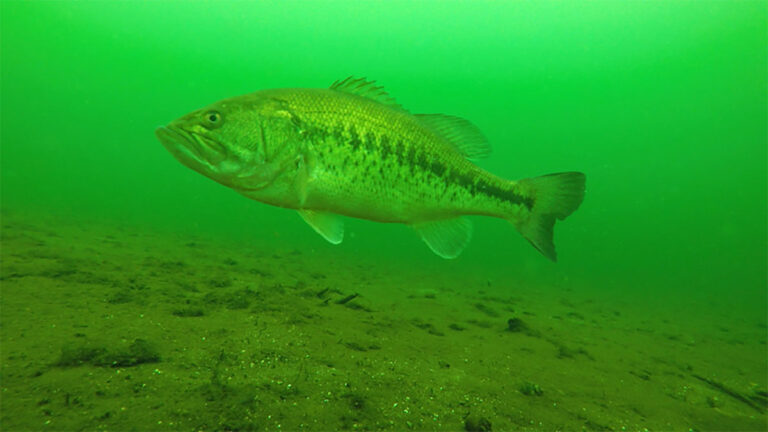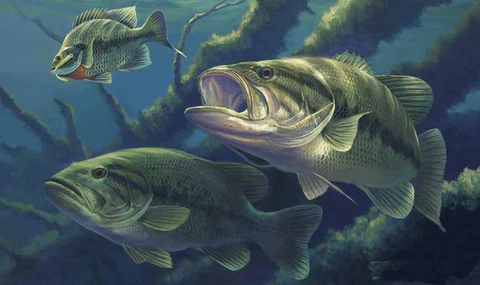When Bass Are Not Biting: How to Catch Lockjaw Bass
Bass fishing is not always easy. There are many days when it seems like bass just won’t bite.
Why are bass not biting? Well, there are lots of factors that decide whether or not a bass will bite.
The unwilling bass are often referred to as “lockjaw” bass. This means they don’t seem to open their mouth to eat anything.
In reality, you can catch bass in all conditions as long as you use the correct approach.
Why Are Bass Not Biting?
There are several reasons why bass might not be biting, causing frustration for anglers.
Understanding these factors can help improve your fishing game and increase your chances of success. Here are some common reasons why bass might not be biting:
- Seasonal Patterns: Bass behavior changes throughout the year due to varying water temperatures and spawning cycles. They may become less active during colder months or when they are protecting their nests.
- Water Temperature: Bass are cold-blooded, and their activity levels are influenced by water temperature. Extreme cold or hot water can slow down their metabolism, leading to reduced feeding.
- Light Conditions: Bass are more active during low-light periods such as early morning, late evening, or overcast days. High sunlight conditions might make them retreat to deeper, shaded areas. You want to stay away from the slow or bad times of day for fishing.
- Weather Changes: Rapid weather fluctuations, especially during cold fronts, can disrupt bass feeding patterns. Sudden changes in barometric pressure and temperature can put bass in a temporary lull.
- Lure Selection: Using the wrong lure or presenting it improperly can deter bass from biting. Matching the lure to the prevailing conditions and mimicking their natural prey is crucial.
- Fishing Pressure: Overfished areas can make bass more cautious and selective about what they bite. Using lures for pressured bass and exploring less-pressured locations might yield better results.
- Water Clarity and Visibility: Murky or clear water can affect bass behavior. In clear water, they might be more cautious, while in muddy water, they rely more on their lateral line to sense vibrations.
- Environmental Disturbances: Loud noises, excessive boat traffic, or sudden movements can spook bass and make them less willing to bite.
- Lack of Patience and Adaptability: Fishing requires patience and adaptability. If you’re not varying your techniques or staying in one spot too long, you might miss opportunities.
By understanding these factors, you can adjust your approach and increase your chances of a successful bass fishing outing.
Seasonal Patterns
- Spring (Most Active Feeding): Spring is considered the prime feeding season for bass. As the water begins to warm up after the colder winter months, bass become more active and start searching for food. They are in preparation for spawning and need to build up energy reserves. During this period, bass feed aggressively on a wide range of prey, including baitfish, insects, and crayfish.
- Summer (Active Feeding): In the early part of summer, bass feeding remains quite active. The warm water temperatures keep their metabolism high, driving them to continue searching for food. They are often found near the shallows, chasing after smaller fish and feeding on aquatic insects.
- Fall (Active Feeding): Fall likely the best time to fish for bass. As the water begins to cool down, bass once again go on a feeding spree to stock up on energy for the upcoming winter months. They tend to follow schools of baitfish and can be found near shorelines and areas with abundant prey.
- Winter (Least Active Feeding): Winter is generally the season when bass feeding slows down significantly. The colder water temperatures lower their metabolic rate, leading to reduced activity and a decreased appetite. During this period, bass tend to move to deeper, more stable water to conserve energy.
Over Pressured Fish
- Increased Caution: Bass can become more cautious and wary of lures and baits due to constant exposure to fishing activities. They quickly learn to associate certain lures with potential danger, making them less likely to bite.
- Selective Feeding: Bass might become more selective in their feeding habits when they encounter frequently used lures. They may prefer natural prey items over artificial lures that they’ve seen multiple times.
- Shift in Feeding Locations: High fishing pressure in specific areas can cause bass to relocate to less-pressured locations. As a result, they might move to deeper waters, under submerged structures, or into areas that are more difficult for anglers to access.
- Altered Feeding Times: Bass may adjust their feeding times to avoid encounters with anglers. They might become more active during low-light periods, such as early morning or late evening, when fishing activity tends to be lower.
- Reduced Population Density: Intense fishing pressure can lead to a decline in bass populations in heavily fished areas. This can result in smaller fish sizes and fewer opportunities for anglers to catch trophy-sized bass.
What to Do When Bass Are Not Biting
When bass are not biting, it can be frustrating, but there are several proactive steps you can take to improve your chances of success and make the most out of your fishing trip. Here’s what to do when bass are not biting.
Change Lures and Presentation
If the bass are not responding to your current lure, try switching to a different type of lure or change its color and size.
Additionally, vary your retrieval speed and patterns to see if that sparks their interest.
Downsize Your Gear
In pressured waters, bass can be more finicky. Consider using lighter fishing line, smaller hooks, and more finesse lure techniques to entice bites from wary bass.
Explore Different Depths
Bass might be holding at varying depths, so try fishing at different water columns. Target shallow areas near the shore as well as deeper structures and drop-offs.
Use Scents and Attractants
Adding scent to your lures or using attractants can make them more appealing to bass, especially in murky water or when they are less active.
Change Fishing Locations
If you’ve been fishing in one spot for a while with no luck, consider moving to a different area. Exploring new locations might lead you to more active bass.
Finesse Fishing to Catch Finicky Bass
Finesse fishing, using smaller and more subtle lures, is incredibly effective for catching finicky bass.
The lifelike movements and non-intrusive presentation mimic natural prey, making it enticing to selective feeders.
Its versatility, patience, and conservation-friendly approach make it a go-to technique, especially in challenging conditions.
Finesse fishing is the key to success when other methods fall short.
Popular Finesse Rigs and Techniques
Several popular finesse fishing techniques have proven effective in enticing bass to bite. Here are some of the most widely used finesse techniques:
- Drop Shot: The drop shot rig is a finesse technique where the hook is tied above a weight, keeping the bait above the bottom. It allows for precise control of the lure’s depth and is highly effective in targeting suspended or finicky bass.
- Ned Rig: The Ned Rig is a simple finesse technique that involves using a small soft plastic stick bait or worm on a lightweight jig head. Its subtle action and natural appearance make it a favorite for catching bass in tough conditions.
- Wacky Rig: The Wacky Rig involves hooking a soft plastic worm through the middle, resulting in a tantalizing and slow-falling presentation. The erratic movement of the bait often triggers strikes from bass, even when they are not actively feeding.
- Shaky Head: The Shaky Head rig consists of a small jig head with a finesse worm or creature bait. When worked slowly on the bottom, the jig head wobbles and shakes, enticing nearby bass to bite.
- Weightless Texas Rig: The Weightless Texas Rig is a finesse presentation where a soft plastic bait, such as a worm or creature bait, is rigged weedless with a hook. This allows the lure to fall slowly and naturally, tempting bass in heavily vegetated areas.
- Finesse Jig: Finesse jigs are smaller and more subtle versions of traditional jigs. They are ideal for presenting a compact and enticing profile to bass in clear or pressured waters.
- Tube Baits: Tube baits are hollow, cylindrical soft plastics that imitate baitfish or crawfish. They can be rigged on a jig head or fished weightless, making them versatile finesse options.
- Finesse Swimbaits: Finesse swimbaits are smaller, more subtle versions of traditional swimbaits. They are great for imitating injured or smaller baitfish and can be effective in clear water conditions.
Key Points
- Lockjaw Bass: Unwilling bass, commonly referred to as “lockjaw” bass, exhibit a reluctance to open their mouths to feed, posing a challenge for anglers.
- Factors Affecting Bass Biting: Various factors influence bass metabolism, aggression, and feeding habits, including seasonal patterns, water temperature, light conditions, weather changes, lure selection, fishing pressure, water clarity, environmental disturbances, and angler patience.
- Seasonal Bass Behavior:
- Spring (Most Active Feeding): Bass are highly active during spring as they prepare for spawning, aggressively feeding on a variety of prey.
- Summer (Active Feeding): Warm water temperatures maintain high metabolism, and bass actively pursue food near shallows.
- Fall (Active Feeding): Fall is an excellent time to fish, with bass feeding to stock up on energy before winter.
- Winter (Least Active Feeding): Colder temperatures reduce bass activity, and they move to deeper waters.
- Over Pressured Fish:
- Increased Caution: Bass become wary of lures due to frequent exposure to fishing activities.
- Selective Feeding: Bass may prefer natural prey over artificial lures they have seen frequently.
- Shift in Feeding Locations: Overfishing can cause bass to relocate to less-pressured areas.
- Altered Feeding Times: Bass may adjust feeding times to avoid encounters with anglers.
- Reduced Population Density: Intense fishing pressure can lead to smaller fish sizes and fewer trophy opportunities.
FAQ
Q1: What can I do when bass are not biting? A1: When bass are unresponsive, try changing lures, downsizing gear, exploring different depths, using scents, and changing fishing locations. Finesse fishing techniques, like drop shot, Ned Rig, and Wacky Rig, can also be effective.
Q2: How do seasonal patterns affect bass behavior? A2: Bass behavior varies throughout the seasons. They are most active during spring and fall, feeding to prepare for spawning and winter. In summer, warm temperatures keep them active, while winter sees reduced feeding due to colder water temperatures.
Q3: Why do over-pressured fish pose a challenge for bass anglers? A3: Over-pressured fish become cautious, selective in feeding, may shift locations, adjust feeding times, and experience reduced population density, affecting the overall fishing experience. Anglers need to adapt their strategies to overcome these challenges.
Also make sure to keep your fishing hooks sharp. This can make the difference when bass are barely biting or slapping at your lure.
Reeling this In
So, there you have it! Our bass fishing journey comes to an end, but remember, those days when bass aren’t biting are just part of the adventure.
Understanding their behavior and using finesse techniques can turn things around.
But fishing isn’t just about the catch; it’s about the memories and the joy of being on the water.
So, embrace the challenge, keep learning, and cherish every moment spent fishing.










